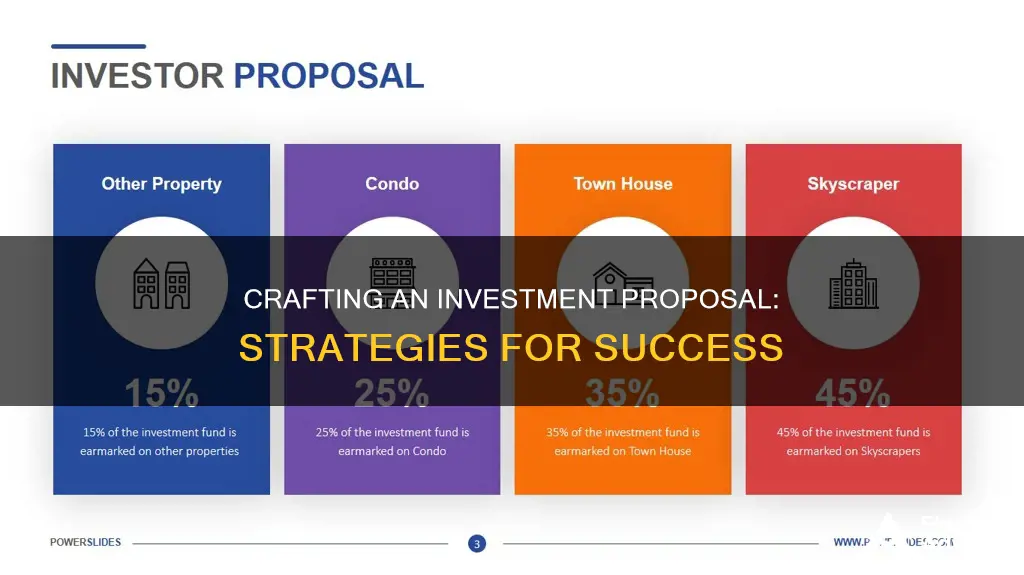
An investment proposal is a document that outlines a business plan to attract investors and secure funding. It is a crucial tool for startups to showcase their value, market potential, and financial viability. The proposal should include an executive summary, project details, marketing and sales strategies, operational logistics, and detailed financial projections, including an exit strategy. It should be clear, concise, and focused on financial details and potential returns to capture investor interest.
| Characteristics | Values |
|---|---|
| Purpose | To raise capital |
| Audience | Potential investors |
| Focus | Business and potential returns to the investor |
| Content | Company financial details, market analysis, sales strategy, operational plan, financial projections, funding requirements, use of funds, exit strategy |
| Tone | Clear, concise, focused on financial details and potential returns |
| Length | Concise, 10-15 pages |
What You'll Learn

Define your company's purpose and goals
When writing an investment proposal, it is important to clearly define your company's purpose and goals. This section of the proposal should provide a concise overview of what your business does, its mission, and its short-term and long-term objectives.
In the company description, you should explain the function of your business, including an overview of the products or services it offers. You may also want to include some background information and a mission statement. For instance, if your startup is branching out from an established business, you can include information about the achievements of the parent company.
The goals section of your proposal should outline your funding requirements and explain how the funds will be used to achieve specific objectives. Be precise about the amount of money you are seeking to raise and provide a detailed breakdown of how it will be allocated. This demonstrates to potential investors that you have a clear plan and helps to instill confidence in your competence.
Additionally, it is important to provide context for your funding request by explaining the market need your business aims to address. You can do this by conducting a competitive analysis and identifying your target market, major competitors, and your approach to positioning and differentiation. This demonstrates your understanding of the market and helps investors see the potential returns on their investment.
Finally, it is crucial to showcase your business's growth potential. Discuss your plans for product development and growth, including statistics about product demand and your current stage in the product development lifecycle. This information will help investors understand the scalability and profitability of your business.
Danaher's Strategic Equity Investments: Unlocking Growth and Innovation
You may want to see also

State the problem your company aims to solve
The problem section of your investment proposal should succinctly describe the specific problem or need in your market segment that your business addresses. It should also cover the pain points and obstacles your customers face in trying to achieve their goals.
For example, if your business offers a time-saving app, you might start by describing the common scenario of people feeling overwhelmed by their tasks and not having enough hours in the day.
You should also explain how current solutions in the market fail to adequately address this need and remove these barriers. For instance, existing solutions might be too costly or complicated for the average user.
By clearly outlining the problem, you can better position your business as the ideal solution and demonstrate that you understand your customers' struggles. This approach builds trust and shows how your business can make their lives easier by solving a genuine problem.
In addition, identifying and addressing user pain points is an important part of developing a strong value proposition, which is crucial for attracting investors.
The Star Performer: Top Investment Strategies for Your Portfolio
You may want to see also

Outline your solution to the problem
This is the part of the proposal where you describe your product or service and how it will benefit your target audience. This is a crucial section for investors, so make it easy to read and understand. If you're sending your proposal via email, consider including different versions to get feedback before finalising it.
Firstly, explain the problem you are aiming to solve and how your product or service will solve it. For example, if your target customers need to achieve something or face pain or obstacles in doing so, and current solutions in the market fail to address that need, your product or service is the solution.
Describe your product or service in detail, including how it will benefit your target audience. If you have a prototype, showcase it to your investors. This will demonstrate that you know how to turn their investment into a working solution.
Next, outline your target market and your user acquisition strategy. Consider valuable channels for that, any past testing, and any technology you are working with. Give projected production volumes, unit prices, sales methods, marketing channels, and overall strategies. Show that you know your product can be profitable and the steps you will take to make that happen.
Give a clear overview of the size of the market you plan to enter. Provide clear amounts for your total addressable market and the served available market, and clearly define the percentage of the market share you aim to capture.
Finally, create a clean table that shows how you have considered all steps to come up with exact dates for your growth and to gain traction.
A Beginner's Guide to TD Ameritrade Investing
You may want to see also

Showcase your market research
Market research is an essential component of your investment proposal. It demonstrates your understanding of the market and your ability to identify new opportunities. This section should include the following:
- Market analysis: Provide a detailed analysis of the market, including current and future trends, supply and demand, competition, and opportunities and threats in your chosen location and niche. Use industry reports, market surveys, census data, and local media to gather this information.
- Competitor analysis: Identify your major competitors and their strengths and weaknesses. Perform a SWOT analysis to outline what they are doing well and where they are lacking. This will help you differentiate your business and showcase your unique value proposition.
- Target market and customer demographics: Clearly define your target market and provide a detailed analysis of your ideal customer, including demographics, needs, and pain points. This will show that you have a thorough understanding of your audience and how to satisfy their needs.
- Marketing and sales strategies: Outline your approach to marketing and sales, including sales strategy for revenue creation, distribution channels, advertising, and content channels. Discuss the pricing model you have chosen and provide a rationale for why it is the most profitable option.
- Data and projections: Support your market research with data and projections. Include statistics, charts, and graphs to visualise your findings and make them more accessible. Use SaaS tools to provide insightful, accurate forecasts of future financial achievements.
- Risk analysis: Identify potential risks and challenges and provide solutions and contingency plans to demonstrate your ability to navigate obstacles.
Smart Strategies to Turn $100K into $1 Million
You may want to see also

Detail your financial projections
Financial projections are a crucial part of an investment proposal, providing data and information that potential investors need to understand your business. They are based on hypothetical situations, using the facts and data you have available. They are often prepared to present a course of action for evaluation and are a type of pro forma statement.
Project your spending and sales
As you develop your business plan, list the key expenditures you will need to make to get your company off the ground and your subsequent costs to operate. Be sure to include recurring expenses such as salaries, rent, insurance, marketing, and raw materials, as well as one-time purchases such as machinery, website design, and vehicles. Research industry spending to get a better idea of the numbers.
Create a sales projection
An accurate sales projection can predict the amount of cash a business can expect to take in over a period. Reference past financial records from similar seasons or track data from competitors. When forecasting total sales, consider factors outside of the company's control, such as taxes and the state of the economy.
Gauge the company's expenses
A company's expenses include all purchases and investments intended to generate revenue, including recurring expenses like salaries, rent, and utilities, and one-time expenses like buying office property or obtaining licenses. Predict recurring expenses by using previous data and balance sheet records, and adjust projections to safeguard against unforeseen expenses.
Create cash flow, income, and balance sheet projections
Use your expense and revenue projections to create a cash flow projection, showing monthly inflows and outflows of money for the first 12 months, and quarterly or yearly projections for the second year. From these, you can prepare annual projected income (profit and loss) statements and balance sheet projections.
Determine your financial needs
Your financial projections will help you see if your business plans are realistic, if you will have shortfalls, and what financing you may require. These documents will be vital for building a case for business loans and attracting investors.
Use the projections for planning
Include various scenarios (most likely, optimistic, and pessimistic) for each projection to help you foresee the financial impacts of each. Your projections can also help you analyze the impact of different strategies, such as pricing, billing efficiency, and equipment choices.
Plan for contingencies
Consider what you would do if an unexpected event threw off your projections. It is a good idea to do some contingency planning and set aside a cash reserve. Many entrepreneurs like to have enough cash for 90 days of operations.
Monitor and adjust
As your business starts operations, compare your projections against actual results to check if you are on target or need to make changes. Monitoring helps you learn about your company's cash flow cycle and spot looming shortfalls early on.
Understanding the Efficient Frontier: Maximizing Investment Portfolio Returns
You may want to see also







